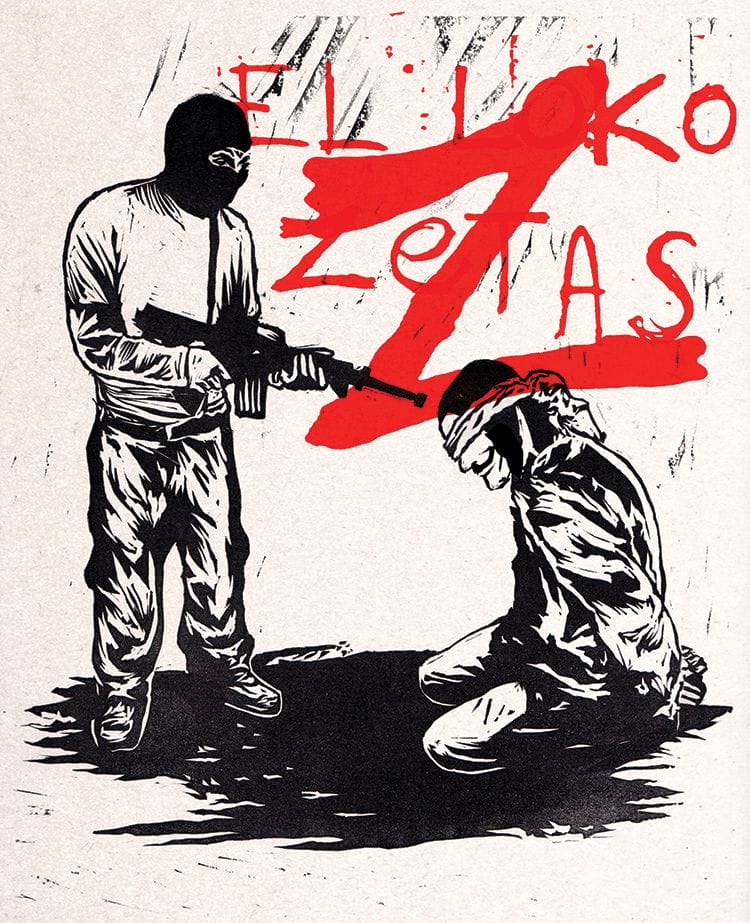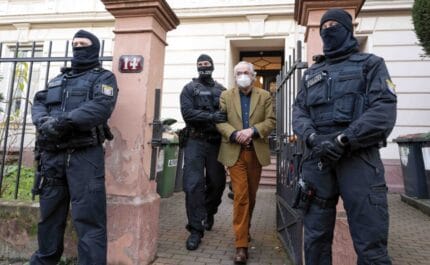Mexican standoff
On 15th July 2013, the leader of the most brutal drug cartel in Mexico was finally arrested. Until the Mexican police took him in, only one enemy had ever truly defeated him – the shadowy super-geeks of Anonymous

Illustrations: Jade They
15th July 2013 (Taken from: #12)
As the clock ticked down towards midnight on November 4th 2011, Miguel Treviño Morales knew he had a serious problem. A violent career criminal who had risen to the leadership of the Los Zetas drug cartel in Mexico, he was not used to being blackmailed. Nobody stood in his way: not politicians, journalists, law enforcement officials nor the long list of rival cartels with whom he battled constantly for territory and respect. If he found the people responsible for the current threats against his organisation, he would kill them in the most brutal manner imaginable. But he couldn’t find them. In a confrontation that had been brewing for years, Treviño Morales and Los Zetas had tangled with the hacktivist collective known as Anonymous and, possibly for the first time in his life, he was about to lose.
Few can be unaware that in the past decade Mexico has seen rising rates of drug-related bloodshed, but the sheer scale of the carnage is hard to imagine. According to work by Rodrigo Canales, an associate professor of organisational behaviour at the Yale School of Management who has extensively studied the cartels, in the last six years 60,000-100,000 people have died in drug-related violence in Mexico. This is eight times larger than the number of combatant casualties in the Iraq and Afghanistan wars combined, and comparable to the casualty count of the first two years of conflict in Syria, the world’s bloodiest ongoing civil war. And even among such brutally violent company, the US has described Los Zetas as “the most technologically advanced, sophisticated and dangerous cartel operating in Mexico.”
Los Zetas first emerged at the turn of the 21st century. Osiel Cárdenas Guillén, who had just taken over control of the Gulf Cartel, was embroiled in a vicious turf war and decided he needed a cadre of the best bodyguards he could find.
He hired a group of deserters from the elite military Grupo Aeromóvil de Fuerzas Especiales (GAFE), trained in commando and urban warfare. The name for this new paramilitary group came from their leader Arturo Guzmán Decena, who (when he was a legitimate soldier) had the Federal Judicial Police radio code “Z1”. Los Zetas became the muscle for the Gulf Cartel.
The man who rose to be the lead enforcer for Los Zetas – and eventually its boss, until his arrest on 15th July this year – did not come from a military background. Treviño Morales was a career criminal who carved his power base out solely through a reputation for unrestrained violence. Anyone who didn’t bow to the wishes of Los Zetas was killed. His method of choice was the guiso (‘stew’), which involved stuffing somebody into an oil drum, dousing them in gasoline, and burning them alive. There are unconfirmed rumours that he would eat the hearts of his victims.
The US has described Los Zetas as ‘the most sophisticated, advanced and dangerous cartel
in Mexico’”
During 2009, the alliance between the Gulf Cartel and Los Zetas began to deteriorate – the latter had become too much of a force in their own right. In January 2010, the Gulf Cartel were foolish enough to kidnap someone who turned out to be a friend of Treviño Morales, which proved to be the catalyst for a complete division. In retaliation, Los Zetas killed 16 Gulf Cartel members and split into their own group. It was the start of a killing spree. As Los Zetas claimed their own drug routes and turf, Treviño Morales is believed to have been behind the massacre of 72 people in San Fernando, Tamaulipas, in 2010, and 193 in the same area the following year. Sometime in 2011, Morales took overall control of Los Zetas.
Treviño Morales’s rise to the top coincided with the opening of a new front in Los Zetas’ all out war for control of the Mexican drug trade. The cartel has dealt ruthlessly with journalists who reported on its activities. More than 50 reporters have died or disappeared since 2006. In response, citizens had – cautiously, slowly – been taking matters into their own hands. Facebook groups, Twitter accounts and forums appeared in which members of the public posted information on cartel activities that wasn’t being reported in the intimidated mainstream press. Websites such as Frontera al Rojo Vivo and Blog del Narco collated the stories.
Naturally, Morales and Los Zetas took this activity as an affront. In the summer of 2011 they posted a series of YouTube clips warning the residents of Veracruz against using social media to provide information to the authorities. This only appeared to fan the flames – the social media activity increased, with Twitter hashtags being used as an effective way to categorise real-time news about what was happening in cartel-controlled towns and cities. The aim was to break the silence over the cartel’s activities, to gain international attention, and to force law enforcement and military agencies to act. In August 2011, Operation Paperstorm saw hundreds of activists take to the streets of Veracruz in a leafleting campaign against the cartels.
Los Zetas responded the only way they knew how. On 13th September 2011, the bodies of two people were found hanging from a bridge in Nuevo Laredo, mutilated and disembowelled. A sign next to the bodies read: “This is going to happen to all those posting funny things on the internet. You better fucking pay attention. I’m about to get you.” The message was signed with a “Z”, the Los Zetas trademark. On 26th September, the decapitated body of Marisol Macias Castaneda was found in a park in Nuevo Laredo. A note left with her body implied that her death was the result of her posting on the anti-cartel blogs using the handle ‘Laredo Girl’.
His method of choice was the guiso – stuffing somebody into an oil drum, dousing them in gasoline and burning them alive”
Laredo Girl’s death got international attention among the hacktivist community, and the retaliation was swift. Using the hashtag #OpCartel, Anonymous claimed responsibility for a Distributed Denial of Service (DDoS) attack on the website of the Veracruz government, widely assumed to be filled with corrupt, cartel-bribed officials. But then Los Zetas appeared to take a step that would escalate the conflict: they kidnapped one of the Anonymous activists.

On 6th October, a clip was posted to YouTube featuring a man in a Guy Fawkes mask speaking to camera – by now, an Anonymous trademark. Speaking continental Spanish, but using Mexican slang, the man announced that a member of Anonymous who had taken part in PaperStorm had been abducted by Los Zetas. He went on to demand the man’s release and to explain what would occur if this did not happen: Anonymous would publicise the names of the buildings and individuals that made up the Los Zetas power base.
“We can’t defend ourselves with a weapon, but if we can do this with their cars, houses, bars, brothels and everything else in their possession…,” he said. “It won’t be difficult. We all know who they are and where they are.” The man continued: “You made a huge mistake by taking one of us. Release him. And if anything happens to him, you (expletive) will always remember this upcoming 5th November.” The video went on to specify the means of retaliation: “On 5th November we will begin to publish the identities of cartel members and their supporters, including taxi drivers, journalists and police officers.”
The kidnapped individual has never been identified. No police report of a kidnapping was ever uncovered, but given the depth of official corruption surrounding Los Zetas, this doesn’t mean that much. There are inherent difficulties in verifying announcements from a decentralised movement like Anonymous, but Barrett Brown – the closest the group had to an official spokesman at the time – asserted that the kidnapping was real (Barrett was arrested in 2012 for allegedly threatening an FBI agent, and remains in jail).
On 29th October, Anonymous hacked the personal website of Gustavo Rosario Torres, former attorney general of the state of Tabasco, and defaced it with accusations that he was a Zeta. (These accusations were not revelatory – Torres had been accused of links with the cartel many times before). On 31st October, another Anonymous video appeared online. As well as saying that the campaign against Los Zetas – now called #OpCartel – would continue, it acknowledged how high the stakes were. Inexperienced activists who might not have robust online security measures were advised to stay away. Anonymous members in Mexico were told not to engage in leafleting or protests, or to purchase or display the trademark Guy Fawkes masks. It appeared that #OpCartel was now being led by serious cybervigilantes within Anonymous, who were probably not based in Mexico.
A leaked report from the time by the intelligence and security consultants Stratfor shows that global security specialists were starting to realise the potential fallout from the confrontation. “If Anonymous carries out its threat, it will almost certainly lead to the deaths of individuals named as cartel associates, whether or not the information released is accurate,” it read. “Furthermore, as Mexican cartels have targeted online journalists and bloggers in the past, hackers could well be targeted for reprisal attacks. Simply disseminating information on cartel members will not significantly impede overall cartel operations, but if Anonymous carries out its threat, it will affect cartel associates and others the cartels could target for retaliatory attacks.”
As the deadline approached, Los Zetas appeared to blink first. A message purporting to be from Anonymous appeared around 4th November, saying the kidnapped man had been released, and that “although bruised, we can say he is safe and well’. But he had been returned along with a message from Los Zetas: for every name related to us that you release, we will kill ten innocent people.
A note scrawled on a blanket near the body read: ‘this happened to me because I didn’t understand I shouldn’t post things on social networks’.”
Treviño Morales had been forced, possibly for the first time ever, to back down – but not without making a bloodthirsty threat. The use of a deadline may well have been the hackers’ saving grace. According to Stratfor: “We have seen reports that Los Zetas are deploying their own teams of computer experts to track those individuals involved in anti-cartel campaigns online, which indicates that the criminal group is taking this very seriously indeed.” Although Anonymous had the upper hand from a technical point of view – able to steal information while concealing their identities – Los Zetas certainly had the funds and the ferocity to either buy or coerce talented hackers into working for them. Had they found any individuals, retribution would have been swift and brutal – and the cartel has been responsible for plenty of assassinations abroad, particularly in the US. The clock may well have been ticking for both sides.
What protected Anonymous was not their online savvy as much as the nature and structure of the movement. Perhaps befitting its military origins, Los Zetas behaves very much like a traditional army – if one with no thought for the Geneva Convention. It relies on identifying targets and attacking them with physical force, and on maintaining control through visible presence. In this scenario, Anonymous operates much more like a guerrilla insurgent force – operating with the support of the population, with members difficult to identify and communications difficult to intercept. By killing publicly and indiscriminately, the cartel could try to intimidate their online adversaries – but their anonymous enemy could vanish, and reappear somewhere else.
As the journalist Malcolm Brown said about Vietnam, a conventional military is to a guerrilla force “like a sledgehammer on a floating cork. Somehow the cork refused to stay down.” This is not to say that Los Zetas didn’t try the sledgehammer approach. On 10th November 2013, a decapitated body was found in Nuevo Laredo, near the border. A note scrawled on a blanket near the body read: “this happened to me because I didn’t understand I shouldn’t post things on social networks.”
But Anonymous haven’t given up on the fight in Mexico either. Before Treviño Morales was arrested, a new online campaign had sprung up in the border town of Ciudad Acuña. Using Twitter accounts and forums – as well as deploying the Anonymous name and Guy Fawkes avatar – a group of hacktivists seemingly local to the area began reporting on the activities of Los Zetas. The activity has taken at least part of the credit for a renewed law enforcement campaign in the region, which in April resulted in an operation involving more than a hundred members of the Mexican army and navy seizing weapons, vehicles and suspects linked to Los Zetas.
Experts are divided on how Los Zetas will evolve in Treviño Morales’ absence, with predictions ranging from a complete fracturing of the organisation into smaller groups, to plain old business as usual. He is currently in prison facing charges of involvement in organised crime, extortion, drug trafficking, money laundering and illegal use of firearms (at the time of writing the only publicly available, concrete evidence against him was that he was captured with $2 million in cash, eight guns and hundreds of rounds of ammunition). The brutality of the members is unlikely to change spontaneously, and neither will their battles online. In October a clip of a woman being beheaded caused an uproar when Facebook initially refused to remove it from their site – it was a Los Zetas execution of a purported member of the Gulf Cartel.
It remains to be seen how ordinary Mexicans (particularly the young, angry and digital-savvy) will act in the future. Let down by corrupt politicians, police, and an intimidated mainstream press, they have seen hope in what can be done as a distributed group, online. The Mexican cartels will intimidate, bribe or kill anybody that gets in their way – if they can find them. With its biggest defence inherent in its name, Anonymous may never have been so important.
Slow Journalism in your inbox, plus infographics, offers and more: sign up for the free DG newsletter. Sign me up
Thanks for signing up.








